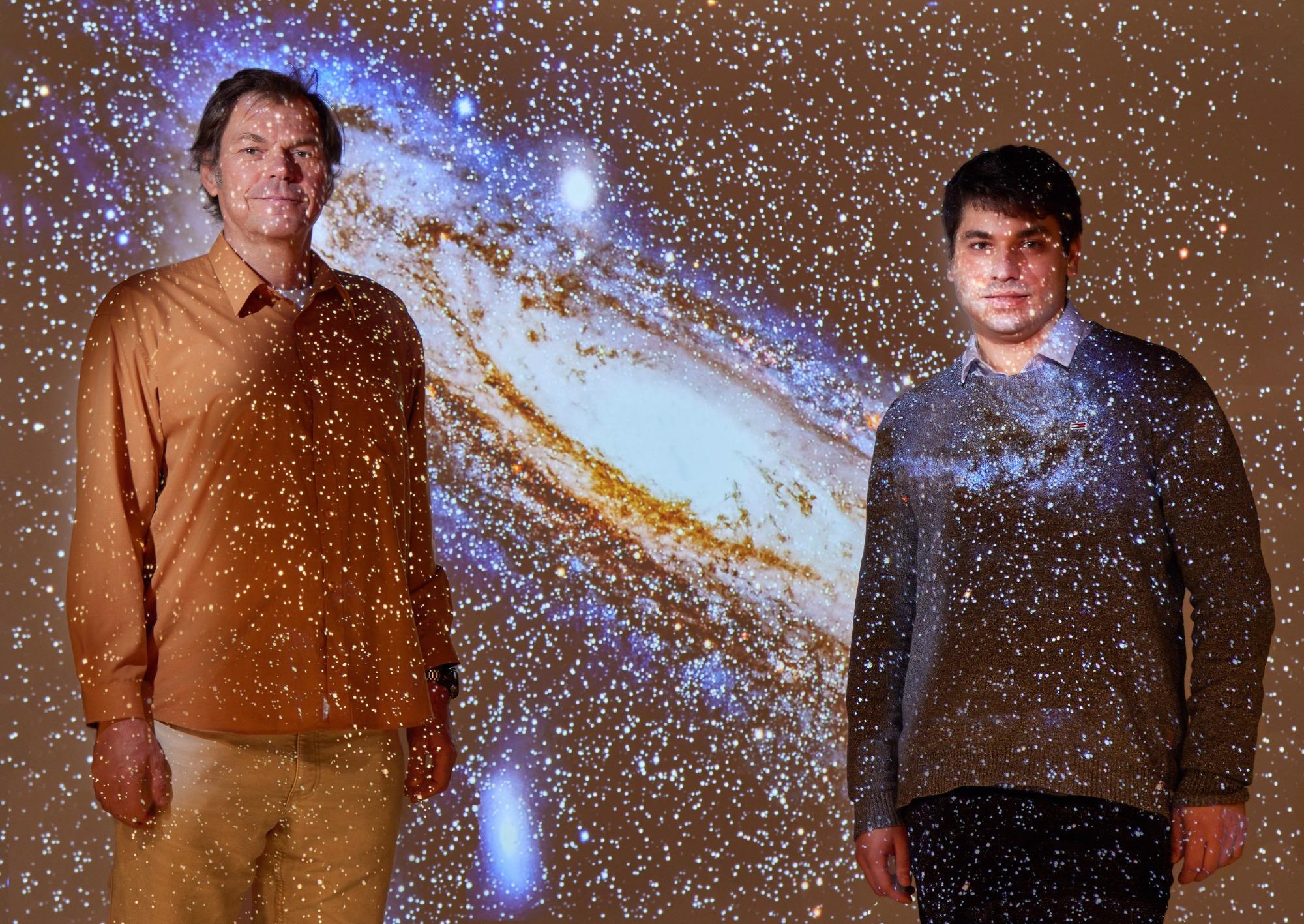Reviewed by Alex SmithFeb 7 2022
The Standard Model of Cosmology illustrates how the universe was created according to the view of a majority of physicists.
 Prof. Dr. Pavel Kroupa (left) and Moritz Haslbauer (right) - with a projection of the Andromeda galaxy. (Image Credit: © Volker Lannert/University of Bonn).
Prof. Dr. Pavel Kroupa (left) and Moritz Haslbauer (right) - with a projection of the Andromeda galaxy. (Image Credit: © Volker Lannert/University of Bonn).
Scientists at the University of Bonn have currently explored the evolution of galaxies within this model, finding significant inconsistencies with actual observations. The University of St. Andrews in Scotland and Charles University in the Czech Republic were also involved in the research. The findings are available in the Astrophysical Journal.
The majority of galaxies observable from Earth look like a flat disk with a thickened center. They are thus like the sports equipment of a discus thrower. According to the Standard Model of Cosmology, however, such disks should develop rather infrequently. The reason is that in the model, every galaxy is encircled by a halo of dark matter. This halo is invisible but employs a powerful gravitational pull on adjacent galaxies because of its mass.
That's why we keep seeing galaxies merging with each other in the model universe.
Dr Pavel Kroupa, Professor, Helmholtz Institute for Radiation and Nuclear Physics, University of Bonn
This crash has two effects, the physicist explains: "First, the galaxies penetrate in the process, destroying the disk shape. Second, it reduces the angular momentum of the new galaxy created by the merger."
Basically, this significantly cuts its rotational speed. The rotating motion generally ensures that the centrifugal forces acting during this process stimulate a new disk to develop. However, if the angular momentum is extremely small, a new disk will not develop at all.
Large Discrepancy Between Prediction and Reality
In the present study, Kroupa's doctoral student, Moritz Haslbauer, directed an international research group to explore the evolution of the universe using the latest supercomputer simulations. The calculations are according to the Standard Model of Cosmology; they exhibit which galaxies should have been created by today if this theory were precise.
The scientists then compared their outcomes with what is presently probably the most exact observational data of the real universe visible from Earth.
"Here we encountered a significant discrepancy between prediction and reality," Haslbauer says: "There are apparently significantly more flat disk galaxies than can be explained by theory."
But, the resolution of the simulations is restricted even on present-day supercomputers. It may therefore be that the number of disk galaxies that would occur in the Standard Model of Cosmology has been miscalculated.
"However, even if we take this effect into account, there remains a serious difference between theory and observation that cannot be remedied," Haslbauer points out.
The situation is not the same for a substitute to the Standard Model, which dispenses with dark matter. According to the so-called MOND theory (the expansion of the acronym is MilgrOmiaN Dynamics), galaxies do not form by combining with each other. Instead, they are created from rotating gas clouds that become more and more thickened.
In a MOND universe, galaxies also develop by trapping gas from their surroundings. However, unions of completely grown galaxies are occasional in MOND.
Our research group in Bonn and Prague has uniquely developed the methods to do calculations in this alternative theory. MOND's predictions are consistent with what we actually see.
Dr Pavel Kroupa, Professor, Helmholtz Institute for Radiation and Nuclear Physics, University of Bonn
Kroupa is also a member of the Transdisciplinary Research Units "Modelling" and "Matter" at the University of Bonn.
Challenge for the Standard Model
However, the precise mechanisms of galaxy formation are still not fully comprehended, even with MOND. Furthermore, in MOND, Newton's laws of gravity do not work under some circumstances but need to be substituted by the correct ones. This would have extensive consequences for other domains of physics.
"Nevertheless, the MOND theory solves all known extragalactic cosmological problems despite being originally formulated to address galaxies only," says Dr. Indranil Banik, who was involved in this research.
Our study proves that young physicists today still have the opportunity to make significant contributions to fundamental physics.
Dr Pavel Kroupa, Professor, Helmholtz Institute for Radiation and Nuclear Physics, University of Bonn
Journal Reference:
Haslbauer, M., et al. (2022) The High Fraction of Thin Disk Galaxies Continues to Challenge ΛCDM Cosmology. Astrophysical Journal. doi.org/10.3847/1538-4357/ac46ac.